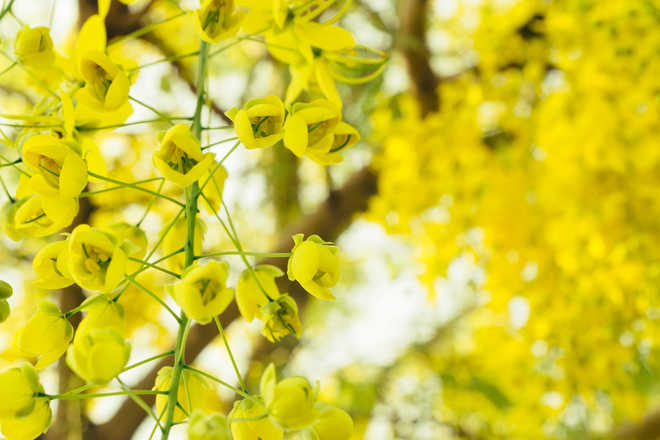Festivals enrich life, remove monotony and bring people together. Each festival has a special meaning and purpose. Among the various festivals celebrated in India, the most pleasing are those associated with the change of season. During the astronomical phenomenon called uttarayana, there are longer days and shorter nights. Everything is fresh, and gives a new look. Basant (Vasanta) Panchami marks the beginning of the spring season. Its arrival is heralded by the melodious notes of cuckoo, and the fragrance of mango blossoms, a popular motif of Indian poets.
According to the Hindu calendar, Basant Panchami falls on the fifth day of the bright half of Magh (January-February). It is also called Shri Panchami in honour of the goddess Saraswati, who is said to combine in herself ‘the functions of all nine Muses of Greek Mythology, presiding over the domain of letters, arts and sciences.’ She is identified with Vak (Vach), the Vedic goddess of speech, and described as the progenitor of the Vedas, of Sanskrit and of the devanagari alphabet. In her iconographic representations, she has snow-white complexion and white attire. She holds veena, the string instrument, the Vedas, a water-pot, and a rosary of crystals in her four hands. She sits on a white lotus, symbol of purity, and rides on peacock, symbol of beauty or a swan, symbol of a discriminative mind. Along with Brahma, she presides over svadhishthana chakra, in the subtle human body. Many acts of piety and devotion are associated with her. She is offered unripe plants of barley, grains of gram, mango blossoms, sweets of white sesame seeds and other edibles. In some parts of India, the clay images of Saraswati are worshipped and subsequently immersed in a nearby tank or river.
Basant Panchami is also associated with the worship of Vishnu, the second of the Hindu triad of gods and his incarnation, Krishna, along with Radha, his divine consort. Kamadeva, god of love, and Rati, goddess of sexual passion, are also remembered on this day due to a Puranic legend associated with them.
In times of yore, Basant Panchami was regarded as an auspicious day for vidyarambha samskara, the official beginning of the primary education of a child, as also for the start of new session in gurukula-s, residential training centres run by highly accomplished teachers. Sacred texts and writing instruments were worshipped on this occasion.
Basant is called ritu-raj, king of seasons, as according to Ayurveda, it provides new vigour to the human body and rouses passion. As weather begins to warm up a little after winter, nature starts pulsating with new life. Birds chirp and fly about joyfully. Trees like palasha (Butea monosperma) bakula (Mimusops elengi) and Ashoka (Saraca asoca) look elegant with new twigs, branches and blossoms. Mustard-fields with yellow flowers light up the heart.
Yellow, in its various hues and shades, has a special significance in the Indian tradition. Materially, the colour stands for happiness and prosperity, and spiritually for inner growth, or a higher form of sacrifice. It also represents pure intellect and pure love. On Basant Panchami, people prefer to wear basanti, yellow, garments. Yellow-coloured halwa made up of flour, ghee and sugar, is prepared at home. Yellow-coloured goods are exchanged between friends and distributed among the poor. Family priests chant sacred hymns, and offer yellow flowers to yajamana-s, the ritual patrons, and receive dakshina, gifts in return.
Basant festivities are marked by public fairs, social gatherings, literary competitions, academic meets, kite-flying, and other recreational activities. So popular is the spring that those born in this month are sometime named after it.
Among the six basic, seasonal ragas or musical modes, mentioned in the ancient texts, Raga Vasanta figures along with Deepak, Megha, Bhairava, Shri, and Malkauns. Raga comes from the root verb ‘ranj’ which means to please or to colour. Anything that colours the mind and affects feelings and emotions, cheers up the listener. Raga Vasanta harmonises man and nature most effectively, and creates positive vibrations within.
In Tantric practices, a number of yantra-s, geometrical diagrams, are prepared or worshipped on Basant Panchmi. Kundalini-awakening becomes possible by the transmutation of pranic energy, which is the highest in this season. Nada, the first vibration of para shakti expressing itself through creation, becomes audible when nature sprouts through every pore of existence.
Basant symbolises beauty and bliss. But it is also associated with heroism. On this day, Hakikat Rai, the brave lad of twelve was martyred for not accepting Islam under coercion. Revolutionary nationalists like Bhagat Singh, Rajguru and Sukhdev fought against the British imperialism, and sacrificed their lives, singing, mera rang de basanti chola - ‘dye me in golden yellow’.
References to the spring season occur in the works of Kalidasa, Kamasutra of Vatsyayana, Ratnavali of Harsha, Ain-i-Akbari of Abul Fazal and in the travelogues of Europeans.
Basant embodies the best in our culture and tradition. Its celebration is an existential response to the changing season after the piercing winter. P.B. Shelley wrote: If winter comes can spring be far behind ?
(Dr Satish K Kapoor, former British Council Scholar, Principal, Lyallpur Khalsa College and Registrar, DAV University, is a noted historian and spiritualist based in Jalandhar city)
Unlock Exclusive Insights with The Tribune Premium
Take your experience further with Premium access.
Thought-provoking Opinions, Expert Analysis, In-depth Insights and other Member Only Benefits
Already a Member? Sign In Now











